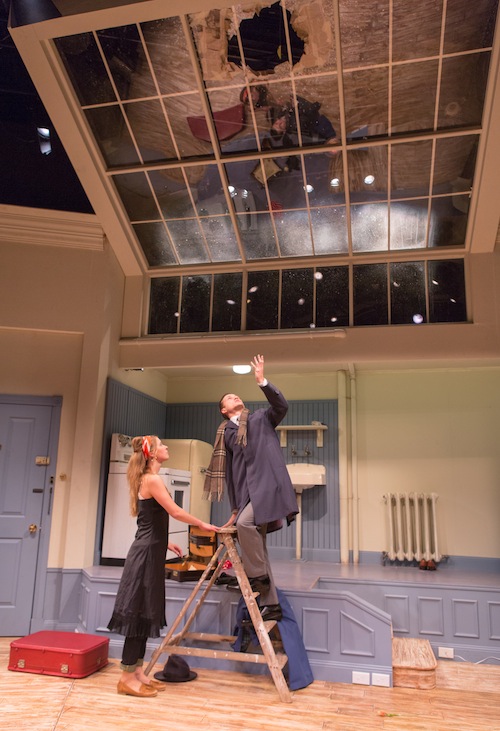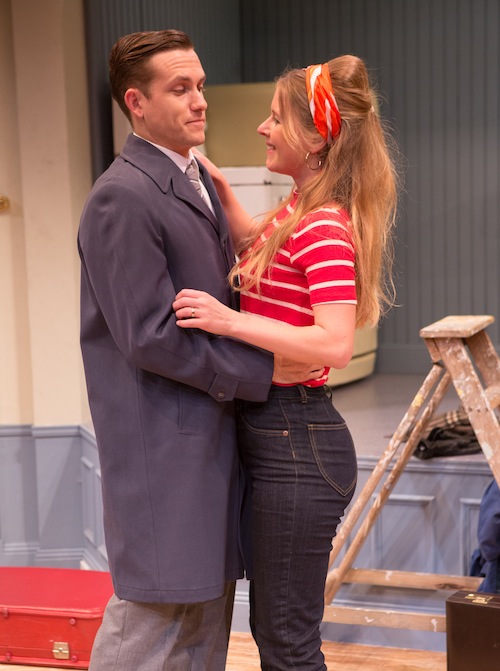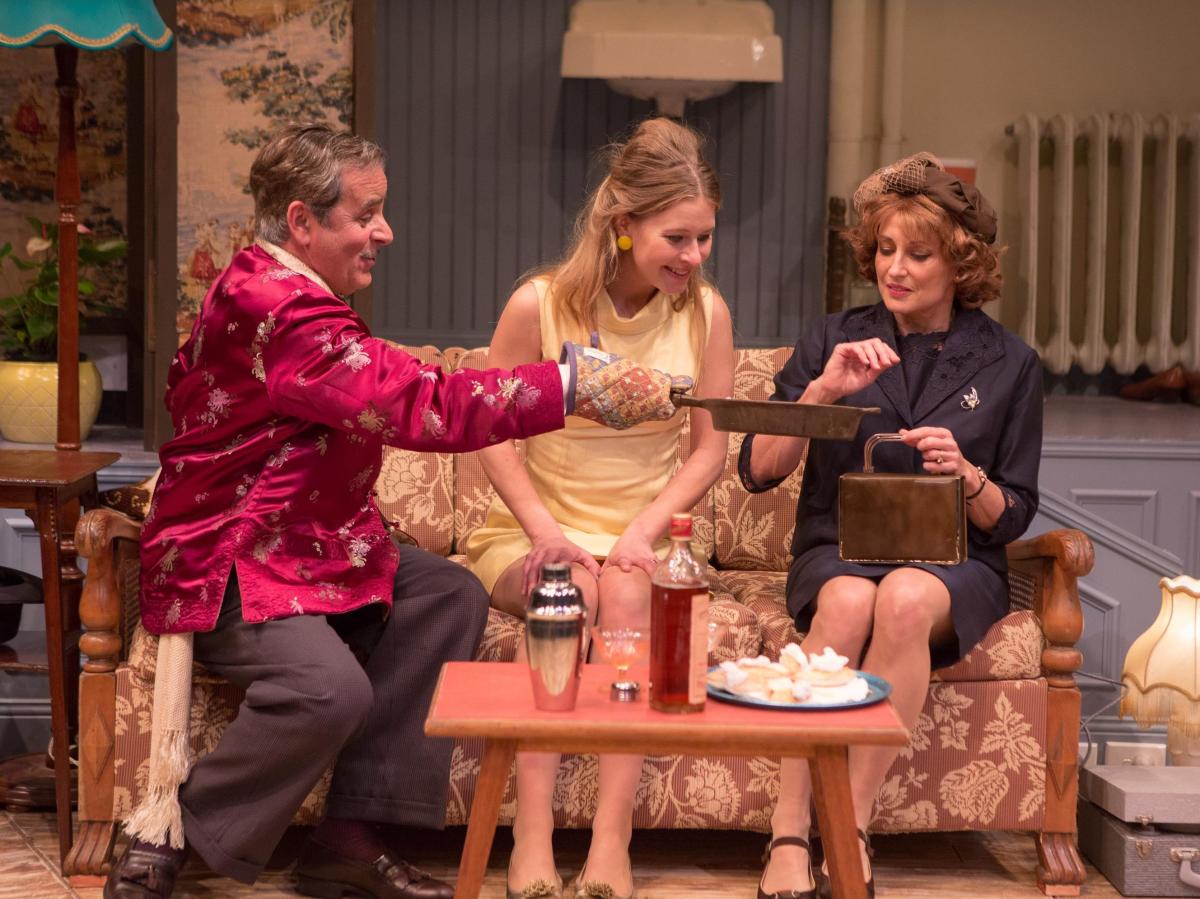Daniel Mitchell, Mia Lethbridge and Georgie Parker in Barefoot in the Park, photo by Clare Hawley
Does life really change that much? Neil Simon’s romantic comedy about newlyweds plays out the stereotypes of youthful passion as timeless – from its raunchy highs to irrational lows – but one might argue that his iconic play also brings our own time into sharp contrast.
Simon’s Barefoot in the Park premiered on Broadway in 1963 staring the young Robert Redford and Elizabeth Ashley. It was Simon’s longest running hit, nominated for three Tony Awards and made into a film in 1967, also starting Redfern and Jane Fonda.
It captured the optimism of an era.
Married for just six days, the effervescent, slightly dippy Corie and her earnest attorney husband, Paul, have moved into a sixth floor walk-up Greenwich Village brownstone. The heating doesn’t work, they share a single bed and snow flurries drift through a hole in the skylight.
While romance may be timeless, the reality is that today’s newly weds would not put up with such conditions, expecting to step directly into their Kardashian-styled lifestyle.
Our contemporary values have become more aligned with those of aspirational, slightly stiff, Paul than the carefree Corie, arguably reversing the zeitgeist of Simon’s 1960s play.

Mia Lethbridge and Jake Speer in Barefoot in the Park, photo by Clare Hawley
Does the play then feel overly nostalgic? I don’t think so. Its messages of optimism and compromise are just as relevant today.
Ensemble’s choice to stage the play – while clearly a box office pleaser – is a nod to the play’s very title. Yes, it is good to walk barefoot through a snowy park every now and again, and it is a timely reminder for audiences.
This play relies on a mature cast to pull off the energy and – I hate to say it – the memory its past celebrity holds upon it.
While Mia Lethbridge is no match for Jane Fonda – a little too “bouncy” and over zealous in trying to capture Corie’s flirty flighty innocence, Georgie Parker is magic in the role of her mother Mrs Bank, or Ethel. The subtlety of emotion – caught between a mother’s concern, overriding desire to interfere, veiled disappointment and genuine love – is delivered so naturally by Parker.

Georgie Parker in Barefoot in the Park, photo by Clare Hawley
Daniel Mitchell is equally enigmatic in his role as the cavalier, flirtatious neighbor Victor Velasco. He reminds us that joie de vivre is ageless, and that it is good to step outside our comfort zone every now and again.
Ensemble’s Artistic Director Mark Kilmurry is very much at home working again with Parker, Mitchell, and Jamie Oxenbould as the very out-of-breath telephone repair man, who between them have appeared in more than 30 productions at Ensemble.
Jake Speer plays a convincing role as Paul. He had three years on Home and Away with Parker and that ease flows onto the Ensemble set.

Jake Speer and Mia Lethbridge in Barefoot in the Park, photo by Clare Hawley
Kilmurry found great rapport in his cast for this tightly scripted play with just five characters. The pace is carried well, and while a predicable plot it didn’t feel tired.
I, on the other hand, was exhausted entering the theatre on opening night, but left buoyant. While that is largely in the craft of the writing by Simon, Kilmurry and his cast pulled the best out of this play. It will not disappoint.
The play’s turning point comes in the second act, in what could be described as “date night” (pictured top), when the four head off to an Albanian restaurant in a godforsaken neighbourhood at the suggestion of Velasco.
For Corie it is the trigger – the big picture question moment. Entering their second week of marriage, she has doubts whether Paul’s spirit is matched to hers.
Paul’s rational arguments are the ballast in the irregularity that has so quickly taken over his life, apartment and now marriage. While the humour is light and tantilising, the tense micro mini-dramas had glorious endings.
‘You can’t go to sleep, we are having a fight.’ Corie insists on a divorce. You have to remember in the early 1960s – when Simon wrote this play – divorce sat around 10 in 1000, where as today that figure has climbed to 550 in 1000.
It could hardly be considered a real threat then, just a tantrum in sync with Corie’s immaturity.
Sexual liberties are also hinted at in the play, with a shadow cast over Ethel that she may have spent a night “in sin” with Victor. But this play was not about burning bras or advancing liberties in the sixties. As with Corie and Paul’s happy ending, so too Ethel’s honour was kept intact.
It returns me to the title – Barefoot in the Park – such an innocent act that carried such gravitas in its rebellion in Simon’s metaphor. I started this review by asking whether life really changes that much when it comes to the story of young love? I am going to argue that it has.
I think the unspoken aspect of this play is its selfish gestures. We are schooled that love is selfless, but there are degrees of self interest in the actions across this play, most obvious in Corie, but also Ethel, Victor and Paul at moments.
Is love selfish? In the 1960s conversation, the answer was an expected no. In today’s version, it is an expected yes.
This was only ever written to be a romantic comedy, but I think Barefoot in the Park is more than just a nostalgic belly-shaker. Delivered by this Ensemble cast it is not only great entertainment, but food for thought – and yes at that obscure Albanian restaurant.
Rating: 4 ½ stars out of 5
Barefoot in the Park
Director: Mark Kilmurry
Assistant Director: Priscilla Jackman
Designer: Alicia Clements
Lighting Designer: Scott Allan
Cast: Mia Lethbridge, Daniel Mitchell, Jamie Oxenbould, Georgie Parker, and Jake Speer
Ensemble Theatre, Kirribili
www.ensemble.com.au
31 August – 8 October 2016





